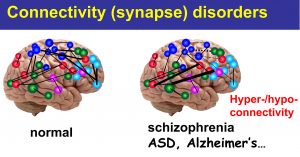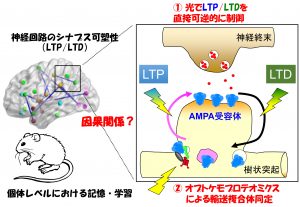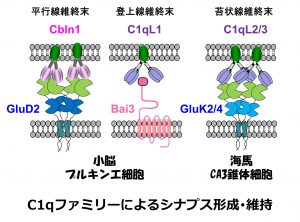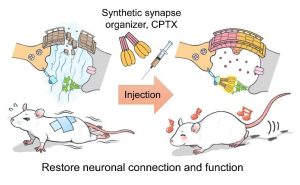Research
In the beginning was the Synapse
Approximately 100 billion neurons connect each other by “synapses” to form various neural circuits in the human brain. While the number of synapses can reach 1,000 trillion, how synapses are actually formed in a circuit- and neuron-specific manner remains incompletely understood. Recent imaging studies have shown that synapses are not only formed by genetic information, but also continuously modified by neuronal activities throughout life. Furthermore, it has become increasingly clear that many neurodevelopmental, neuropsychiatric and neurological disorders, such as autism spectral disorders, schizophrenia and Alzheimer’s diseases, are caused by defects in synaptic functions. Therefore, it is essential to clarify how synapses are formed, maintained and modified to better understand how our brain functions and dysfunctions in physiological and pathological conditions, respectively.、Toward this goal、To demonstrate the respective functions such as motor function It made up by that neural network。focusing、 on、two。major、projects。as、Synaptic is not only formed on the basis of genetic information、follows。Synapse is what、Us human is the source makes them human。Practical、By the research results of recent years、Ya psychiatric disorders such as depression, schizophrenia、Developmental disorders such as autism spectrum disorders、Furthermore, neurological disorders such as dementia, including the Alzheimer's disease is believed to be a "synaptic disease"。
It made up by that neural network。focusing、 on、two。major、projects。as、Synaptic is not only formed on the basis of genetic information、follows。Synapse is what、Us human is the source makes them human。Practical、By the research results of recent years、Ya psychiatric disorders such as depression, schizophrenia、Developmental disorders such as autism spectrum disorders、Furthermore, neurological disorders such as dementia, including the Alzheimer's disease is believed to be a "synaptic disease"。
What are we studying?
Depending on neural activity、Phenomenon that efficiency of signaling at the synapse is increased long-term (long-term potentiation:Long-term potentiation (LTP)) And phenomena to be reduced (long-term depression:Long-term depression (LTD))It has been known。Such a change is what、It is thought that the substance of the medium-term storage (the unit of time in the case of human-Sun) from short-term。On the other hand、More long-term memory (Mon-year) is、It is believed to have been borne by morphological changes, such as synapse itself is extinguished or or the newly formed。In yuzu 﨑研、The two phenomena:① functional changes of synapses (LTP / LTD)、Morphological changes such as ② synapse formation, maintenance, and removal、What molecular mechanisms are responsible for this、It aims to clarify how to participate in the change of neural circuits and behavior at the individual level。
Is it to be useful to what kind of things?
How functionally changed synapses、How formed or synapses、It is maintained、And either lost by going to、To elucidate the process that is、To understand the pathogenesis of synaptic unusually wide range of psychiatric and neurological disorders and developmental disorders with a cause、It is very important in order to develop a new treatment method。Various development will be considered such as:。However、Important thing is、That a better understanding of the phenomenon that is happening at the synapseIs the、Application method believe comes from then。
- Why foster a healthy brain by to elucidate whether certain of learning is approved only in childhood (even triplets of soul hundred) at the molecular level
- By elucidating the abnormality in the synapses that cause mental illness, developmental disabilities、Lead to new fundamental diagnostic methods and treatment methods
- Before the nerve cell death occurs、It prevents the progression of dementia due to intervention synaptic levels
- In regenerative medicine by iPS cell-derived nerve cell transplantation、Enhanced recovery by promoting synapse formation。
I will have any research specifically…
1) using optogenetics
Research on LTP/LTD mechanism

Synaptic plasticity phenomenon in response to neural activity、Long-term potentiation that occurs in response to artificially electrical stimulation, which was added to the synapse(LTP)And long-term depression(LTD)And it has been studied for many years as a model。However、In this way, the LTP / LTD induced、Do learning and memory and the cause-and-effect relationship in an individual level there is really、Fundamental question has been left unresolved that。We、By light stimulus、By developing optogenetic tool (PhotonSABER) can be operated directly acute and reversibly LTD in targeted synaptic、Motor learning in the cerebellum has succeeded in it to prove directly that are borne by LTD (Neuron, 2018)。By further developing such a tool、We aim to elucidate the molecular mechanisms responsible for the entity of medium-term memory from short-term。
2) To understand how synapses are formed focusing on the C1q complement family
Is a molecule which recognizes a foreign substance in the natural immune system "complement C1q" is evolutionarily very old molecule。Interestingly、C1q to similar group of molecules (complement family of molecules) is not only the immune system、We have discovered that to control the synapse formation and maturation process in the central nervous system。
In the cerebellum、Parallel fibers are axons of the granule cells will form dendrites and synapses of Purkinje cells。Complement family molecules Cbln1 is secreted from the parallel fibers、At the same time it binds neurexins (Nrx) present in parallel fibers、δ2 type glutamate receptor present on Purkinje cells(GluD2)It also binds to。Tripartite complex consisting of the Nrx-Cbln1-GluD2 is、We have reported that it is essential for the adhesion of the synapses between parallel fibers and Purkinje cells (Science 2010; 2016)。Tojo fibers also form dendrites and synapses of Purkinje cells, which are axons inferior olive。C1ql1 of complement family molecules are secreted from the climbing fiber、To control and maintain maturity of climbing fiber over Purkinje cell synapses by binding to the Bai3 is a seven-transmembrane adhesion molecules present in the Purkinje cell we were heading (Neuron 2014)。Parallel fiber - Purkinje cell、In two synapses of climbing fiber over Purkinje cells、Cbln1, Complement family molecule that is different that C1ql1 is released each、I think a very interesting cause synapse formation is in on the dendrites of Purkinje cells to compete。
The responsible for the excitatory neurotransmitter in our brain but is glutamate receptors、AMPA receptors in the glutamate receptor is a fast neurotransmission、Kainate receptors is responsible for slow transmission。Kainate receptors in the brain is highly expressed in the CA3 pyramidal cells of the hippocampus、Especially by integrating the postsynaptic make the mossy fibers (axons of dentate gyrus granule cells)、It plays an important role in order to cause the temporal and spatial summation of neural activity。On the other hand、In temporal lobe epilepsy, this kainate receptor plays a major role in epileptic focus formation due to its additivity.
I will。Ever the mossy fibers synapse rear to kainate receptor is why integration was quite a mystery。We complement family molecule C1qL2 that is secreted from the mossy fibers C1ql3 is what、In CA3 pyramidal cells and found to be a molecule that determines the accumulation of kainate receptor to mossy fibers postsynaptic (Neuron, 2016)。Complement family molecules or are synthesized by neuronal activity、It has the property of or are secreted、Since also associated with inflammation is deep、It is expected to be involved in the pathogenesis of various diseases。
3) development of artificial synaptic connectors
Synapses that make up various neural circuits in the brain、By elucidating what kind of synapse-forming molecules are formed and maintained、Develop artificial synaptic connectors with properties that do not exist in nature。So far、all

We have elucidated the crystal structure of neuronal pentraxin 1 (Nptx1), which binds to glutamate receptors present at excitatory synapses in brain circuits.、By combining its structure with Cbln1, which exhibits strong synaptogenesis in the cerebellum、A new artificial synapse organizer CPTX (=Cbln1 + Nptx1)was successfully developed (Science 2020)。CPTX is
It has the property of being able to strongly connect synapses even in neural circuits other than the cerebellum.、CPTX cerebellar ataxia、.、When administered to model mice of spinal cord injury、synapses formed within a few days、improved coordination、Recovery of learning and memory functions、Recovery of motor function of paralyzed hind legs, etc.、We were able to lead to significant improvement in each pathology.。By developing such artificial synaptic connectors、autism spectrum disorder、schizophrenia、It is expected that this will lead to the creation and application of new therapeutic strategies for synaptic diseases such as Alzheimer's disease.。
—English version—
In the Beginning was the Synapse
Approximately 100 billion neurons connect each other by “synapses” to form various neural circuits in the human brain. While the number of synapses can reach 1,000 trillion, how synapses are actually formed in a circuit- and neuron-specific manner remains incompletely understood. Recent imaging studies have shown that synapses are not only formed by genetic information, but also continuously modified by neuronal activities throughout life. Furthermore, it has become increasingly clear that many neurodevelopmental, neuropsychiatric and neurological disorders, such as autism spectral disorders, schizophrenia and Alzheimer’s diseases, are caused by defects in synaptic functions. Therefore, it is essential to clarify how synapses are formed, maintained and modified to better understand how our brain functions and dysfunctions in physiological and pathological conditions, respectively. Toward this goal, we are focusing on two major projects as follows:
What do we study?
1) Changes in functional synaptic connectivity by neuronal activities
Synaptic connectivity is functionally modified by changes in neuronal activities, a phenomenon known as synaptic plasticity. Long-term potentiation (LTP) and long-term depression (LTD) of excitatory neurotransmission have been intensively studied as models of synaptic plasticity mediating learning and memory. While it has become clear that LTP and LTD are mainly caused by activity-induced increase and decrease in the number of postsynaptic AMPA-type glutamate receptors (AMPARs) that directly mediates fast excitatory neurotransmission, respectively, it remains incompletely clear whether and how LTP and LTD are causally linked to brain functions mediating specific behavioral changes in vivo. To address this question, Yuzaki laboratory is developing optogenetic tools that can directly regulate LTP and LTD in living animals.
2) Changes in structural synaptic connectivity by synaptic organizers
Molecules that regulate synapse formation, maintenance and modification are referred to as synaptic organizers. They are classified into two major classes, cell-adhesion molecules, such as neurexin and neuroligin, and secreted diffusible factors, such as Wnt and FGF. Interestingly, certain secreted factors are retained in the extracellular matrix at the synaptic cleft and serve as extracellular scaffolds for pre- and post-synaptic proteins, and thus referred to as extracellular scaffolding proteins (ESPs). The ESP-type of synaptic organizers includes neuronal pentraxins and C1q family proteins, which is characterized by the presence of the C-terminal globular C1q domain. Clk, the prototype of the C1q family, belongs to the complement innate immune system and recognizes various foreign objects. Yuzaki laboratory has found that C1q family proteins, such as cerebellins (Cblns) and C1q-like proteins (C1qLs) are predominantly expressed in the CNS and have been characterizing their functions at synapses.
—
Recent representative papers (Since 2005 ):
For details:  https://orcid.org/0000-0002-5750-3544
https://orcid.org/0000-0002-5750-3544
- Kakegawa W*, Paternain AV, Matsuda K, Isabel AM, Iida I, Miura E, Nozawa K, Yamasaki T, Sakimura K, Yuzaki M **, Lerma J*. Kainate receptors regulate synaptic integrity and plasticity by forming a complex with synaptic organizers in the cerebellum. Cell Reports 43:114427, 2024.
- Itoh M, Piot L, Mony L, Paoletti P*, Yuzaki M.* Lack of evidence for direct ligand-gated ion channel activity of GluD receptors Proc Natl Acad Sci USA 121:e2406655121, 2024.
- Nozawa K, Sogabe T, Hayashi A., Motohashi J, Miura E, Arai I, Them so M *. In vivo nanoscopic landscape of neurexin ligands underlying anterograde synapse specification. Neuron. 110:3168-3185, 2022..
- Ojima K†, Kakegawa W†, Yamasaki T, Miura Y, Itoh M, Michibata Y, Kubota R, Doura T, Miura E, Nonaka H, Mizuno S, Takahashi S, Them so M *, Hamachi I *, Kiyonaka S**. Coordination chemogenetics for activation of GPCR-type glutamate receptors in brain tissue. Nat Commun. 13(1):3167, 2022.
- Suzuki K†, Elegheert J †, Song I†, Sasakura H †, Senkov O, Matsuda K, Kakegawa W, Clayton AJ, Chang VT, Ferrer Ferrer M, Miura E, Kaushik R,Ikeno M, And Morioka, Takeuchi Y, Shimada T, Otsuka S, Stoyanov S, Watanabe M, Takeuchi K, Dityatev A*, Aricescu AR *, Yuzaki M ** . A synthetic synaptic organizer protein restores glutamatergic neuronal circuits. Science 369:eabb4853, 2020. (†Co-first, *Co-corresponding, **Lead author)
- Ibata K, Kono M, Narumi S, Motohashi J, Kakegawa W, Kohda K, Yuzaki M. Activity-dependent secretion of synaptic organizer Cbln1 from lysosomes in granule cell axons. Neuron. 102:1184-1198, 2019.
- Kono M, Kakegawa W, Yoshida K, Yuzaki M. Interneuronal NMDA receptors regulate long-term depression and motor learning in the cerebellum. J Physiol. 597:903-920, 2019.
- Kakegawa W, Katoh A, Narumi S, Miura E, Motohashi J, Takahashi A, Kohda K, Fukazawa Y, Yuzaki M **, Matsuda S*. Optogenetic Control of Synaptic AMPA Receptor Endocytosis Reveals Roles of LTD in Motor Learning.Neuron. 99:985-998, 2018. (*Co-corresponding authors; **Lead author).
- Yuzaki M. Two Classes of Secreted Synaptic Organizers in the Central Nervous System,,en,Annu Rev Physiol,,en, 2017,,en. Annu Rev Physiol80:243-262, 2018.
- Satake T, Yamashita K, Hayashi K, Miyatake S, Tamura-Nakano M, Doi H, Furuta Y, Shioi G, Miura E, Takeo YH, Yoshida K, Yahikozawa H, Matsumoto N, Yuzaki M, Suzuki S. MTCL1 plays an essential role in maintaining Purkinje neuron axon initial segment. EMBO J 36:1227-1242, 2017.
- Wakayama S, Kiyonaka S, Arai I, Kakegawa W, Matsuda S, Ibata K, Nemoto YL, Kusumi A, Yuzaki M, Hamachi I. Chemical labeling for visualizing native AMPA receptors in live neurons. Nature Commun 8:14850, 2017.
- Yuzaki M, Aricescu AR. A GluD Coming-Of-Age Story. Trends Neurosci 40:138-150, 2017.
- Otsuka S, Konno K, Abe M, Motohashi J, Kohda K, Sakimura K, Watanabe M, Yuzaki M. Roles of Cbln1 in Non-Motor Functions of Mice. J Neurosci, 36:11801-11816, 2016.
- Elegheert J, Kakegawa W, clay, Shanks N, Behiels e, Matsuda K, Kohda K, Miura E, Rossmann M, Mitakidis N, Motohashi J, Chang VT, Siebold C, Greger IH, Nakagawa T, Them so M *, Aricescu AR *. Structural basis for integration of GluD receptors within synaptic organizer complexes. Science 353:295-299, 2016. (*co-corresponding author).
- Kiyonaka S, Kubota R, Michibata Y, Sakakura M, Takahashi H, Numata T, Inoue R, Yuzaki M, Hamachi I. Allosteric activation of membrane-bound glutamate receptors using coordination chemistry within living cells. Nature Chem 8 :958-967, 2016.
- Matsuda K, Budisantoso T, Mitakidis N, Sugaya Y, Miura E, Kakegawa W, Yamasaki M, Konno K, Uchigashima M, Abe M, Watanabe I, Kano M, Watanabe M, Sakimura K, Aricescu AR, Yuzaki M. Trans-synaptic modulation of kainate receptor functions by C1q-like proteins. Neuron. 90:752-767, 2016.
- Takeo YH, Kakegawa W, Miura E, Yuzaki M. RORα Regulates Multiple Aspects of Dendrite Development in Cerebellar Purkinje Cells In Vivo. J Neurosci 35:12518-12534, 2015.
- Kakegawa W, Mitakidis N, Miura E, Abe M, Matsuda K, Takeo YH, Kohda K, Motohashi J, Takahashi A, Nagao S, Muramatsu SI, Watanabe M, Sakimura K, Aricescu AR, Yuzaki M. Anterograde C1ql1 signaling is required in order to determine and maintain a single-winner climbing fiber in the mouse cerebellum. Neuron. 85:316-329, 2015.
- Matsuda S, Kakegawa W, Budisantoso T, Nomura T, Kohda K, Yuzaki M. Stargazin regulates AMPA receptor trafficking through adaptor protein complexes during long–term depression. Nature Commun 4:2759, 2013.
- Kohda K, Kakegawa W, Matsuda S, Yamamoto T, Hirano H, Yuzaki M. The d2 glutamate receptor gates long-term depression by coordinating interactions between two AMPA receptor phosphorylation sites. Proc Natl Acad Sci USA 110:E948-957, 2013.
- Ito-Ishida A, Miyazaki T, Miura E, Matsuda K, Watanabe M, Them so M *, Okabe S*. Presynaptically released Cbln1 induces dynamic axonal structural changes by interacting with GluD2 during cerebellar synapse formation.Neuron. 76:549-564, 2012. (*co-corresponding author).
- Unokai T, Matsuda S, Kakegawa W, UT, Kohda K, Suzuki A, Funakoshi Y, Hasegawa H, Them so M *, Kanaho Y. NMDA receptor-mediated PIP5K activation to produce PI(4,5)P2 is essential for AMPA receptor endocytosis during LTD.Neuron. 73: 135-148, 2012. (*co-corresponding author)
- Kakegawa W, Miyoshi Y, Hamase, C, Matsuda S, Matsuda K, Kohda K, Emi K, Motohashi J, Konno R, The Zaitsu, Yuzaki M. D-Serine regulates cerebellar LTD and motor coordination through the delta2 glutamate receptor.Nature Neurosci 14: 603-611, 2011.
- Yuzaki M. Cbln1 and its family proteins in synapse formation and maintenance.Curr Opin Neurobiol21:215-220, 2011.
- With Jitsuki, Takemoto K, Kawasaki T, Then H, Takahashi A, Becamel C, Sano A, Yuzaki M, Zukin RS, Ziff EB, Kessels HW, Takahashi T. Serotonin mediates cross-modal reorganization of cortical circuits.Neuron. 69: 780-92, 2011.
- Matsuda K, Miura E, Miyzaki T, Kakegawa W, Emi K, Narumi S, Fukazawa Y, Ito-Ishida A, Kondo T, Shigemoto R, Watanabe M, Yuzaki M. Cbln1 is a ligand for an orphan glutamate receptor δ2, a bidirectional synapse organizer.Science 328: 363-368, 2010.
- Nishiyama J, Matsuda K, Kakegawa W, Yamada N, Motohashi J, Mizushima N, Yuzaki M. Reevaluation of neurodegeneration in lurcher mice: constitutive ion fluxes cause cell death with, not by, autophagy.J Neurosci 30:2177-87, 2010.
- Kakegawa, W., Miyazaki, T., Kohda, K., Matsuda, K., Emi, K., Motohashi, J., Watanabe, M., Yuzaki, M. The N-terminal domain of GluD2 (GluRd2) recruits presynaptic terminals and regulates synaptogenesis in the cerebellum in vivo, J Neurosci 29:5738-5748, 2009.
- Iijima, T., Emi., K., Yuzaki, M. Activity-dependent repression of Cbln1 expression: mechanism for developmental and homeostatic regulation of synapses in the cerebellum.J. Neurosci29:5425-5434、2009.
- Matsuda S, Miura E, Matsuda K, Kakegawa W, Kohda K, Watanabe M, Yuzaki M. Accumulation of AMPA Receptors in Autophagosomes in Neuronal Axons Lacking Adaptor Protein AP-4.Neuron. 57: 1-16, 2008.
- Ito-Ishida, A., Miura, E., Emi, K., Matsuda, K., Iijima, T., Kondo, T., Kohda, C. Watanabe, M., Yuzaki, M. Cbln1 Regulates Rapid Formation and Maintenance of Excitatory Synapses in Mature Cerebellar Purkinje Cellsin vitro andin vivo. J Neurosci 28:5920-5930, 2008.
- Kakegawa, W., Miyazaki, T., Emi, K., Matsuda, K., Kohda, K., Motohashi, J., Mishina, M., Kawahara, S., Watanabe, M., Yuzaki, M. Differential Regulation of Synaptic Plasticity and Cerebellar Motor Learning by the C-terminal PDZ-Binding Motif of GluRdelta2.J Neurosci 28:1460-1468, 2008.
- Kakegawa,W., Kohda, K., Yuzaki, M. The delta2 “ionotropic” glutamate receptor functions as a non-ionotropic receptor to control cerebellar synaptic plasticity.J Physiol 584:89-96, 2007.
- Kakegawa, W., Miyazaki, T., Hirai, H., Motohashi, J., Mishina, M., Watanabe, M., Yuzaki, M. Ca2+ permeability of the channel pore is not essential for the delta2 glutamate receptor to regulate synaptic plasticity and motor coordination.J Physiol 579.3:729-735, 2007.
- Hirai H, Pang Z, Bao D, Miyazaki T, Li L, Miura E, Parris J, Rong Y, Watanabe W, Them so M *, Morgan JI. Cbln1 is essential for synaptic integrity and plasticity in the cerebellum.Nature Neurosci 8: 1534-1541, 2005. (*co-corresponding author)